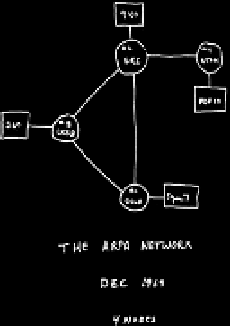Information Technology Reference
In-Depth Information
the first two problems had already been solved by Baran and Davies. The use of
a store-and-forward network solved the problem of needing to have every com-
puter connected to every other computer. Furthermore, a distributed network,
rather than a hierarchical or centralized network, would allow multiple paths
between the origin and destination of the messages. Second, the work of Baran
and Davies on splitting up the messages into fixed-length packets had shown
that a packet-switching network allowed more efficient use of each communi-
cation line than a standard message-switching network. Using packets, a single
user would not take up the bandwidth of each link, as in a circuit-switched
telephone call. Roberts first learned about packet switching and about Baran's
work from Roger Scantlebury at the Gatlinburg conference in October 1967.
Roberts had found a solution to his third problem at another conference
earlier that year. After a meeting in Ann Arbor, Michigan, in a taxi back to
the airport, Wes Clark, another Lincoln Lab veteran, outlined a solution to the
problem of each site having to write multiple different versions of interface
software for its computer to handle the data communication with the other,
different computers. Clark suggested inserting a minicomputer between each
mainframe host computer and the network. Each site would then only have to
create software to connect its mainframe to the standard network minicom-
puter. A similar solution had been proposed by the NPL team at the later con-
ference in October. Roberts called the intermediate computers that managed
the packet routing and delivery
interface message processors
, or IMPs.
It was at the Ann Arbor meeting that Roberts realized that he also had a
sociological challenge on his hands. Many university researchers felt they had
worked hard to get funding for “their” computers and were not enthusiastic
about having to “waste time” writing software to enable others to use their
valuable resources. Roberts noticed a distinct regional bias:
Fig. 10.12. A sketch by Alex McKenzie
of the initial four-node configuration
of ARPANET connecting the University
of California at Santa Barbara, the
University of Utah, UCLA, and SRI. The
communication backbone of the net-
work was provided by fifty kilobit per
second telephone links.
We actually had more conservatism on the East Coast. When I looked for sites
that were willing to start, the four West Coast sites were interested and excited
to be involved. And the East Coast sites, like MIT, said “Well, I don't want you
to touch my computer.” So we went with the ones that were cooperative. . . .
16
Two of the groups on the West Coast who were enthusiastic about being con-
nected to a network were Doug Engelbart's team at the Stanford Research
Institute (SRI) and Len Kleinrock's Network Measurement Center at the
University of California, Los Angeles (UCLA) (
B.10.11
). Engelbart was working
on NLS, his oNLine System for interacting with computers, and he saw the
ARPANET proposal as an opportunity to extend his system to support distrib-
uted collaboration. Kleinrock had been a PhD student at MIT with Roberts,
and in his 1962 thesis had used
queueing theory
, the mathematical modeling of
queue lengths and waiting times, to simulate the behavior of store-and-forward
message-switching networks. His network simulations had used mathematical
models for both the rate of message generation and for the distribution of mes-
sage lengths. The other two groups who responded favorably to networking
their sites were the University of California, Santa Barbara, and the University
of Utah, both working on ARPA-funded interactive graphics research. The first
four nodes of the ARPANET were therefore all on the West Coast of the United
States (
Fig. 10.12
).
B.10.11. Len Kleinrock ran the
Network Measurement Center at
UCLA. He is photographed here with
the first IMP.


Search WWH ::

Custom Search